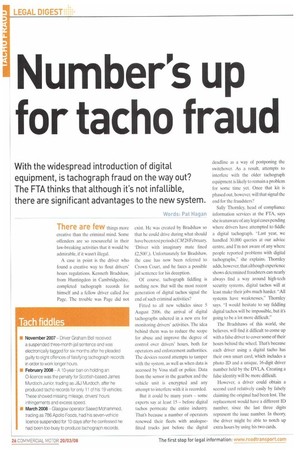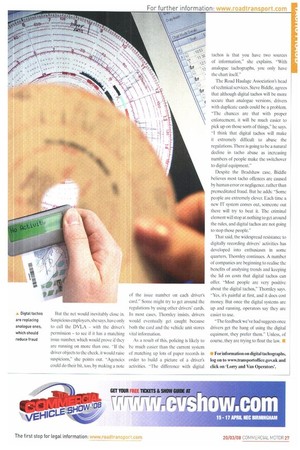Number's up for tacho fraud
Page 26

Page 27

If you've noticed an error in this article please click here to report it so we can fix it.
With the widespread introduction of digital equipment, is tachograph fraud on the way out? The FTA thinks that although it's not infallible, there are significant advantages to the new system.
Words: Pat Hagan
There are few things more creative than the criminal mind. Some offenders are so resourceful in their law-breaking activities that it would be admirable, if it wasn't illegal.
A case in point is the driver who found a creative way to flout drivers' hours regulations. Kenneth Bradshaw, from Huntingdon in Cambridgeshire. completed tachograph records for himself and a fellow driver called Joe Page. The trouble was Page did not exist. He was created by Bradshaw so that he could drive during what should have been rest periods (CM28 February. 'Driver with imaginary mate fined 12,500'0. Unfortunately for Bradshaw, the case has now been referred to Crown Court, and he faces a possible jail sentence for his deception.
Of course. tachograph fiddling is nothing new. But will the most recent generation of digital tachos signal the end of such criminal activities?
Fitted to all new vehicles since 5 August 2006, the arrival of digital tachographs ushered in a new era for monitoring drivers' activities. The idea behind them was to reduce the scope for abuse and improve the degree of control over drivers' hours, both for operators and enforcement authorities. The devices record attempts to tamper with the system, as well as when data is accessed by Vosa staff or police. Data from the sensor in the gearbox and the vehicle unit is encrypted and any attempt to interfere with it is recorded.
But it could be many years some experts say at least 15 before digital tachos permeate the entire industry. That's because a number of operators renewed their fleets with analoguefitted trucks just before the digital deadline as a way of postponing the switchover. As a result, attempts to interfere with the older tachograph equipment is likely to remain a problem for some time yet. Once that kit is phased out, however, will that signal the end for the fraudsters?
Sally Thornley, head of compliance information services at the FTA, says she is unaware of any legal cases pending where drivers have attempted to fiddle a digital tachograph. "Last year, we handled 30.000 queries at our advice centre, and I'm not aware of any where people reported problems with digital tachographs," she explains. Thornley adds, however, that although experience shows determined fraudsters can nearly always find a way around high-tech security systems, digital tachos will at least make their jobs much harder. "All systems have weaknesses," Thornley says. "I would hesitate to say fiddling digital tachos will be impossible, but it's going to be a lot more difficult."
The Bradshaws of this world, she believes, will find it difficult to come up with a false driver to cover some of their hours behind the wheel. That's because each driver using a digital tacho has their own smart card, which includes a photo ID and a unique, 16-digit driver number held by the DVLA. Creating a false identity will be more difficult.
However, a driver could obtain a second card relatively easily by falsely claiming the original had been lost. The replacement would have a different ID number, since the last three digits represent the issue number. In theory, the driver might be able to notch up extra hours by using his two cards. But the net would inevitably close in. Suspicious employers, she says, have only to call the DVLA with the driver's permission to see if it has a matching issue number, which would prove if they are running on more than one. -If the driver objects to the check, it would raise suspicions," she points out. "Agencies could do their bit, too, by making a note of the issue number on each driver's card.Some might try to get around the regulations by using other drivers' cards. In most cases. Thomley insists, drivers would eventually get caught because both the card and the vehicle unit stores vital information.
As a result of this, policing is likely to be much easier than the current system of matching up lots of paper records in order to build a picture of a driver's activities. "The difference with digital tachos is that you have two sources of information," she explains. "With analogue tachographs, you only have the chart itself."
The Road Haulage Association's head of technical services, Steve Biddle, agrees that although digital tachos will be more secure than analogue versions, drivers with duplicate cards could be a problem. "The chances are that with proper enforcement, it will be much easier to pick up on those sorts of things,he says. "I think that digital tachos will make it extremely difficult to abuse the regulations. There is going to be a natural decline in tacho abuse as increasing numbers of people make the switchover to digital equipment.
Despite the Bradshaw case, Biddle believes most tacho offences are caused by human error or negligence, rather than premeditated fraud. But he adds: -Some people are extremely clever. Each time a new IT system comes out, someone out there will try to beat it. The criminal element will stop at nothing to get around the rules, and digital tachos are not going to stop those people."
That said, the widespread resistance to digitally recording drivers' activities has developed into enthusiasm in some quarters, Thornley continues. A number of companies are beginning to realise the benefits of analysing trends and keeping the lid on costs that digital tachos can offer. "Most people are very positive about the digital tachos," Thomley says. -Yes, it's painful at first, and it does cost money. But once the digital systems are up and running, operators say they are easier to use.
-The feedback we've had suggests once drivers get the hang of using the digital equiment, they prefer them." Unless, of course, they are trying to flout the law.








































































































































































